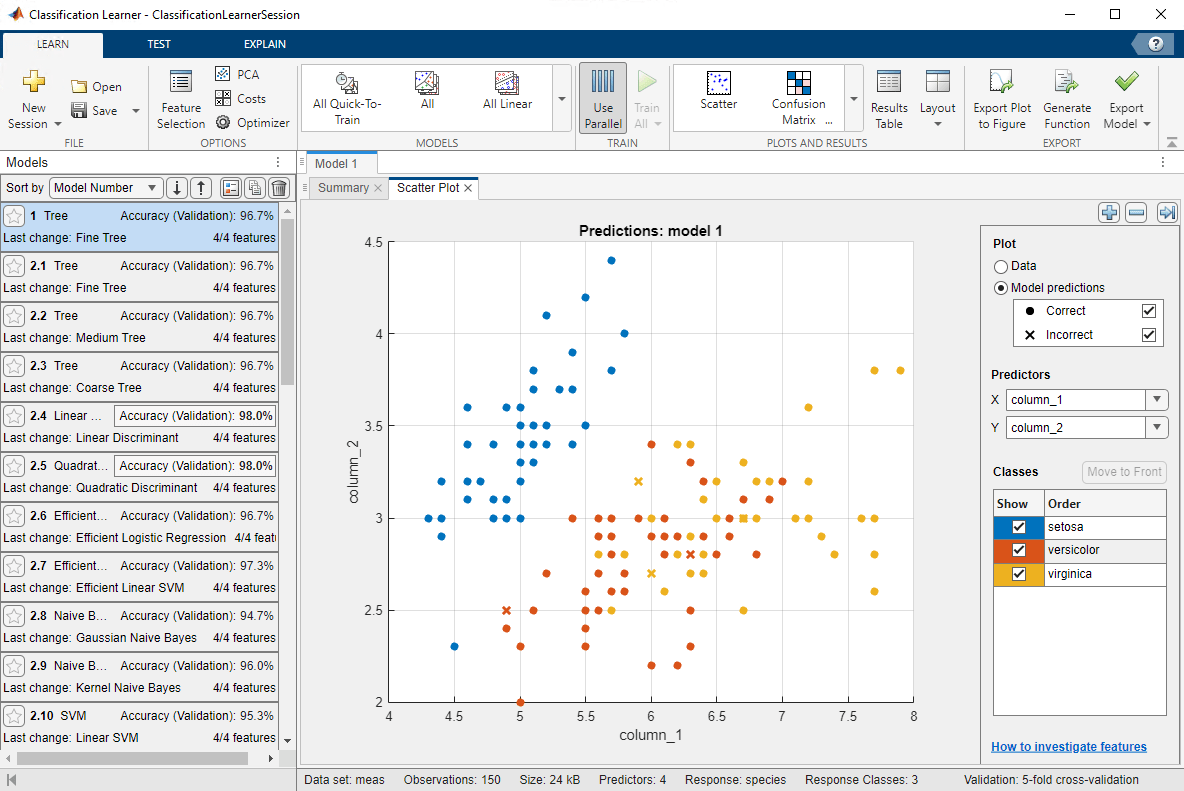Classification Learner
Train models to classify data using supervised machine learning
Description
The Classification Learner app trains models to classify data. Using this app, you can explore supervised machine learning using various classifiers. You can explore your data, select features, specify validation schemes, train models, and assess results. You can perform automated training to search for the best classification model type, including decision trees, discriminant analysis, support vector machines, logistic regression, nearest neighbors, naive Bayes, kernel approximation, ensemble, and neural network classification.
You can perform supervised machine learning by supplying a known set of input data (observations or examples) and known responses to the data (labels or classes). You use the data to train a model that generates predictions for the response to new data. To use the model with new data, or to learn about programmatic classification, you can export the model to the workspace or generate MATLAB® code to recreate the trained model.
Tip
To get started, in the Classifier list, try All Quick-To-Train to train a selection of models. See Automated Classifier Training.
More
Required Products
MATLAB
Statistics and Machine Learning Toolbox™

Open the Classification Learner App
MATLAB Toolstrip: On the Apps tab, under Machine Learning, click the app icon.
MATLAB command prompt: Enter
classificationLearner.
Examples
- Train Classification Models in Classification Learner App
- Select Data for Classification or Open Saved App Session
- Automated Classifier Training
- Feature Selection and Feature Transformation Using Classification Learner App
- Choose Classifier Options
- Visualize and Assess Classifier Performance in Classification Learner
- Export Classification Model to Predict New Data
Programmatic Use
classificationLearner
classificationLearner opens the Classification Learner app or
brings focus to the app if it is already open.
classificationLearner(Tbl,ResponseVarName)
classificationLearner(Tbl,ResponseVarName) opens the
Classification Learner app and populates the New Session from Arguments dialog box
with the data contained in the table Tbl. The
ResponseVarName argument, specified as a character vector or
string scalar, is the name of the response variable in Tbl that
contains the class labels. The response variable cannot contain more than 500 unique
class labels. The remaining variables in Tbl are the predictor
variables.
classificationLearner(Tbl,Y)
classificationLearner(Tbl,Y) opens the Classification Learner
app and populates the New Session from Arguments dialog box with the predictor
variables in the table Tbl and the class labels in the vector
Y. You can specify the response Y as a
categorical array, character array, string array, logical vector, numeric vector, or
cell array of character vectors. Y cannot contain more than 500
unique class labels.
classificationLearner(X,Y)
classificationLearner(X,Y) opens the Classification Learner
app and populates the New Session from Arguments dialog box with the
n-by-p predictor matrix
X and the n class labels in the vector
Y. Each row of X corresponds to one
observation, and each column corresponds to one variable. The length of
Y and the number of rows of X must be
equal. Y cannot contain more than 500 unique class labels.
classificationLearner(___,Name,Value)
classificationLearner(___,Name,Value) specifies
cross-validation options using one or more of the following name-value arguments in
addition to any of the input argument combinations in the previous syntaxes. For
example, you can specify "KFold",10 to use a 10-fold
cross-validation scheme.
"CrossVal", specified as"on"(default) or"off", is the cross-validation flag. If you specify"on", then the app uses 5-fold cross-validation. If you specify"off", then the app uses resubstitution validation.You can override the
"CrossVal"cross-validation setting by using the"Holdout"or"KFold"name-value argument. You can specify only one of these arguments at a time."Holdout", specified as a numeric scalar in the range [0.05,0.5], is the fraction of the data used for holdout validation. The app uses the remaining data for training (and testing, if specified)."KFold", specified as a positive integer in the range [2,50], is the number of folds to use for cross-validation."TestDataFraction", specified as a numeric scalar in the range [0,0.5], is the fraction of the data reserved for testing.
classificationLearner(filename)
classificationLearner(filename) opens the Classification
Learner app with the previously saved session in filename. The
filename argument, specified as a character vector or string
scalar, must include the name of a Classification Learner session file and the path
to the file, if it is not in the current folder. The file must have the extension
.mat.
Limitations
Classification Learner does not support model deployment to MATLAB Production Server™ in MATLAB Online™.
Version History
Introduced in R2015a
See Also
Apps
Functions
fitctree|fitcdiscr|fitcsvm|fitclinear|fitcecoc|fitcknn|fitckernel|fitcensemble|fitcnet|fitglm
MATLAB Command
You clicked a link that corresponds to this MATLAB command:
Run the command by entering it in the MATLAB Command Window. Web browsers do not support MATLAB commands.

Select a Web Site
Choose a web site to get translated content where available and see local events and offers. Based on your location, we recommend that you select: .
You can also select a web site from the following list:
How to Get Best Site Performance
Select the China site (in Chinese or English) for best site performance. Other bat365 country sites are not optimized for visits from your location.
Americas
- América Latina (Español)
- Canada (English)
- United States (English)
Europe
- Belgium (English)
- Denmark (English)
- Deutschland (Deutsch)
- España (Español)
- Finland (English)
- France (Français)
- Ireland (English)
- Italia (Italiano)
- Luxembourg (English)
- Netherlands (English)
- Norway (English)
- Österreich (Deutsch)
- Portugal (English)
- Sweden (English)
- Switzerland
- United Kingdom (English)
